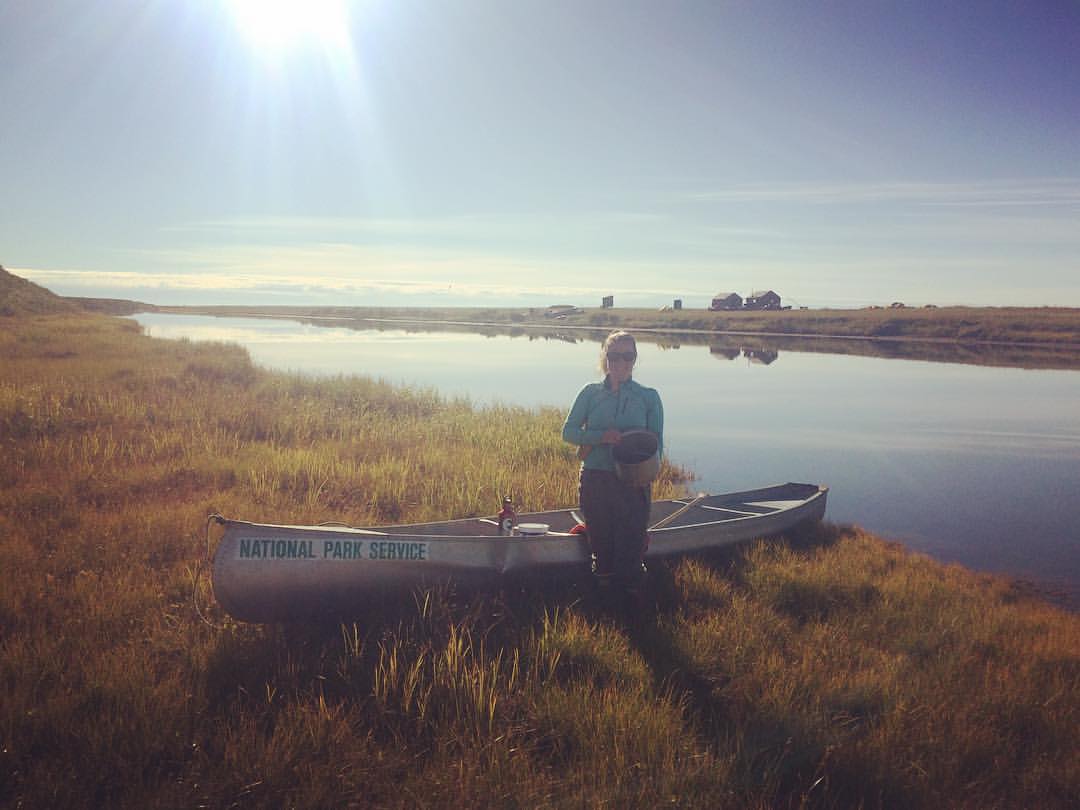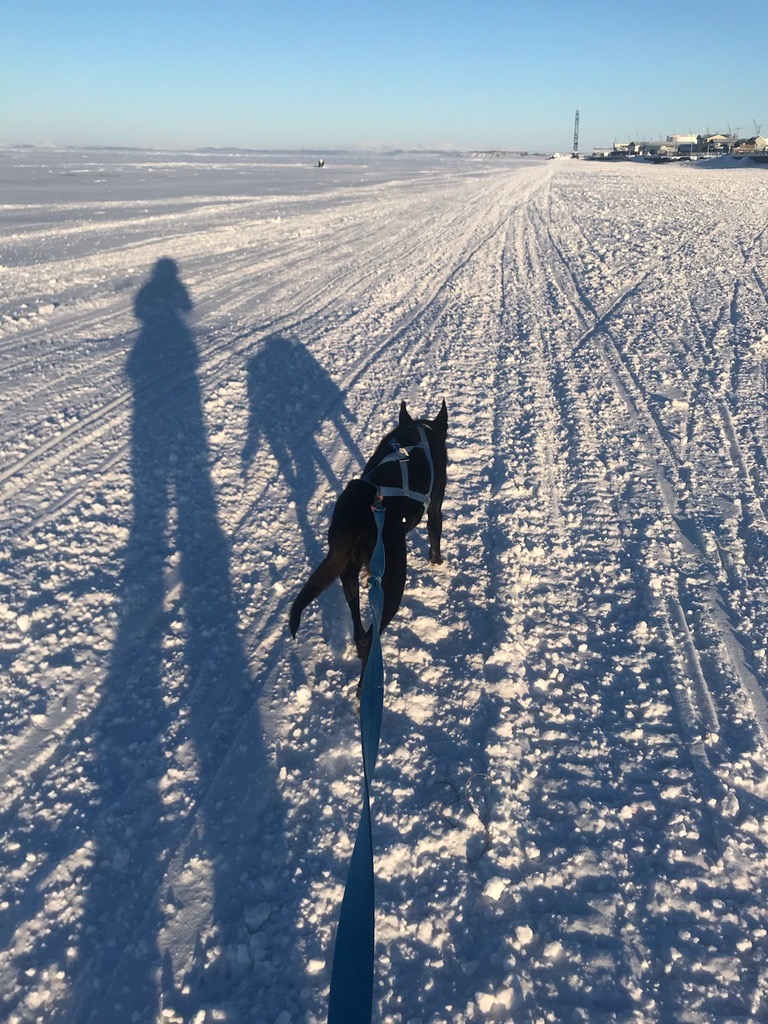Hi, my name is Deanna! I’m a Ranger with Kobuk Valley National Park, Cape Krusenstern National Monument, and Noatak National Preserve. These parks are incredibly remote and challenging to get to. They are some of the least visited National Park sites because of their location above the Arctic Circle.
We have the added challenge of living in a community that still requires a plane, snowmachine, or boat ride to get out to them! The National Park headquarters for these park units is located in Kotzebue, Alaska. It’s where us rangers make our home!
I’m relatively new here and I’ve been learning about these National Park units through the eyes of my coworkers. As virtual visitors, I’d like to introduce you to some of the faces and stories of these parks!
Today I was able to speak with Hannah, our cultural anthropologist. In Inupiaq, Hannah goes by the name Aliitchak. Her role at the parks is subsistence management, working with communities on land use, language, and culture projects, and working with hunters and harvesters to navigate the federal subsistence program.
Subsistence- The harvest and processing of wild resources for food, raw materials, and other traditional uses.
------------------------------------------------------------------------------------------------------------

When did you move to Kotzebue?
My family and I moved to Kotzebue from Washington in 2006 when I was 14 years old. It was right before my freshman year of high school. I actually worked at the front desk of the Northwest Arctic Heritage Center during my senior year of high school. I moved away for college, but would come back during the summers to work as an archaeological technician for the park. I moved back in 2014 to work for the park, in my current role.
What are some memories that you have from growing up in Kotzebue?
I remember going sledding in high school, which was kind of a big deal. We would go to Cemetery Hill, the main sledding hill.
One of my first memorable social gatherings was berry picking in the fall. School had started and it was berry picking season, so I got invited to go out with a group of people.
What were your first impressions moving up here?
I remember how hard it was and I was confused about who I wanted to be, just like any teenager is. I was going into high school and experiencing all of the changes from that. I was in a new culture and in a new town. I was very focused on being normal and having normal experiences.
A lot of my first impressions were trying to compare things to what I thought was normal and then trying to create a sense of normalcy. Once I let go of that, I started to see how beautiful this place was. I remember how hard it was to hold onto my thoughts of what was normal, and found it was much better when I let that go.
Favorite hobbies? 
I have really been enjoying *skijoring, I have 2 sled dogs and I was able to learn from a local musher. A friend of mine was learning at the same time as me. I was encouraged by the both of them to get out.
It has been a fun way to learn about skiing and it also helps to be able to learn about dogs, the culture of raising dogs, and using dogs for transportation, as well as the relationship between humans and dogs when you are working together to get somewhere. It is slow travel, but you can see the details of the places you are traveling around.
Hannah Fun Fact: Her and her dog have done over 100 miles in the past 2 months, with the longest trip being about 25 miles!
*Skijoring is when dogs are in a harness that is connected to a belt hooked around a person, while the person is on skis.
Do you have a favorite spot in any of the park units?
Anigaaq at Cape Krusenstern. It is a beautiful landscape and has been lived on for the past 4,000 years. There are subsistence camps, making it very important for the people of Kotzebue. There is also a ranger cabin out there. It is a beautiful place to do subsistence activities yourself, including berry picking and fishing.
What’s the hardest part of living in Kotzebue?
Being remote in rural America and Alaska means we are lacking a lot of important resources for health and safety. That is really hard on this community. It has taken me a long time to learn the struggles that my neighbors have. It takes a long time and a lot of patience to understand them and understand the historical context of these issues.
Overcoming that hurdle is finding ways to support one another. It doesn’t make up for the issues or the lack of resources, but there are ways to be support one another.
Tell us about an accomplishment or unique work story.
When I first started I was doing a lot of backcountry archaeological surveys. There were amazing moments with that, such as flying in a helicopter over the Brooks Range and camping on a barrier island or gathering your drinking water from little ponds.
My biggest accomplishment and the work that I’m most excited about recently is working in the 10 surrounding villages and forming relationships with the people of those communities. Kotzebue is the largest community within the Northwest Arctic Region. The ten surrounding villages are Kivalina, Noatak, Kiana, Ambler, Kobuk, Selawik, Buckland, Deering, Noorvik, Shungnak, and Kiana. There are no roads connecting these communities. In order to visit you need to take a plane, a ride on a snow machine, or a boat.
I have been to every village at some point during my work. Each community has a unique heritage and way of life that connects them to the land around them.
What is something you have been able to do up here that you believe is unique to Kotzebue or life above the Arctic Circle?
Every year I help organize a *400 mile sled dog race. I get to see mushers from all over Alaska to come participate in the race, and some mushers from outside of Alaska too.
I get to spend time with the cutest doggie athletes. My favorite part is right before the race they are howling and jumping up and down because they are so excited to get going. The whole town is out there to be able to witness that.
When they come back from the race, the look tired, but incredibly accomplished.
Another cool part is seeing a cultural practice that has been alive in this region for thousands of years and will continue for more years to come.
*The Kobuk 440 is the premier distance dog sled race of the Arctic, where people come together to celebrate Inupiaq culture, way of life, respect for nature, and heritage.
What are the most common questions you get from friends, family, or acquaintances who live outside of Alaska?
The most common question is the question of why? Why do people live there? It’s hard for people who live in more populated places to understand why people would live out here.
Many people don’t realize that there are towns in the U.S. that are off of the road system (Kotzebue itself has no connecting roads and no road system). They might not even know enough about it to be able to ask that question!
These are the lands of the Inupiaq people and many people don’t have knowledge about Indigenous people living off of the land. The Inupiaq people still want to live here and have lots of ties here. That’s very important to them.
There are more Indigenous people writing stories and making media to be able to share their stories. There are increasingly more resources to be able to explain why people live out here.
What should virtual visitors remember about this place? What should visitors who plan to come here make time for when visiting?
However you visit, know these lands are the Inupiaq peoples’ homelands. They have a connection to the land here unlike anyone else can have. It’s healthy and thriving and a place that is changing.
It’s really complex, and it’s okay not to understand everything, as long as we try!
We should be open to other ways of thinking and other ways of being. We can be respectful. With that open-mindedness you can see how important this land is to the people living here, while seeing some really beautiful things.
This place will continue to exist whether visitors are here or not. It is important on its own.
------------------------------------------------------------------------------------------------------------
As we wrapped up the interview, Hannah pronounced a few Inupiaq words for me. Learning a new language is hard, but her passion to help guide anyone wanting to learn is evident. I have found that I learn best from people who are passionate about their work. If your excitement, love, and care shows, then I too am convinced I need to care and learn about this topic.
That’s how it was when speaking to Hannah. Not only did I get to look into her early life living in Kotzebue, but I was able to hear a transformation that took place in her through her words. Taikuu, Hannah.
*Taikuu means thank you in Inupiaq
